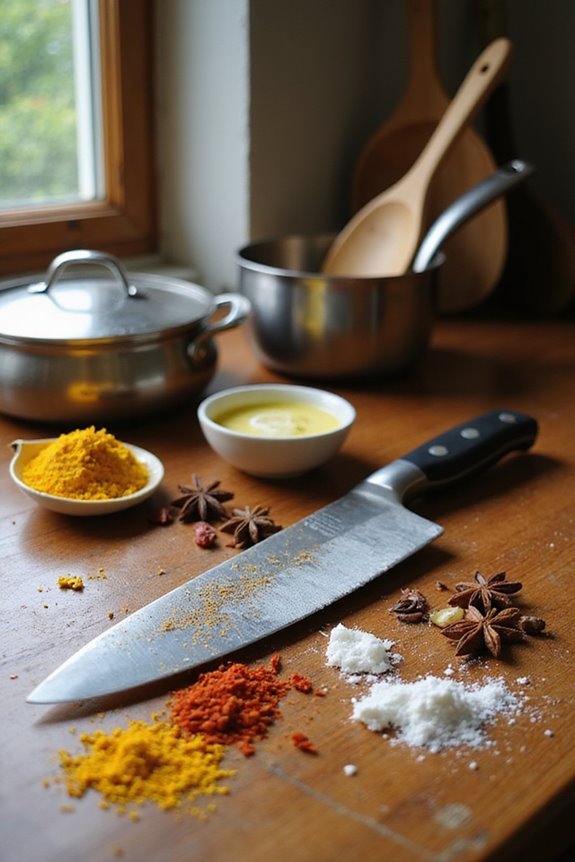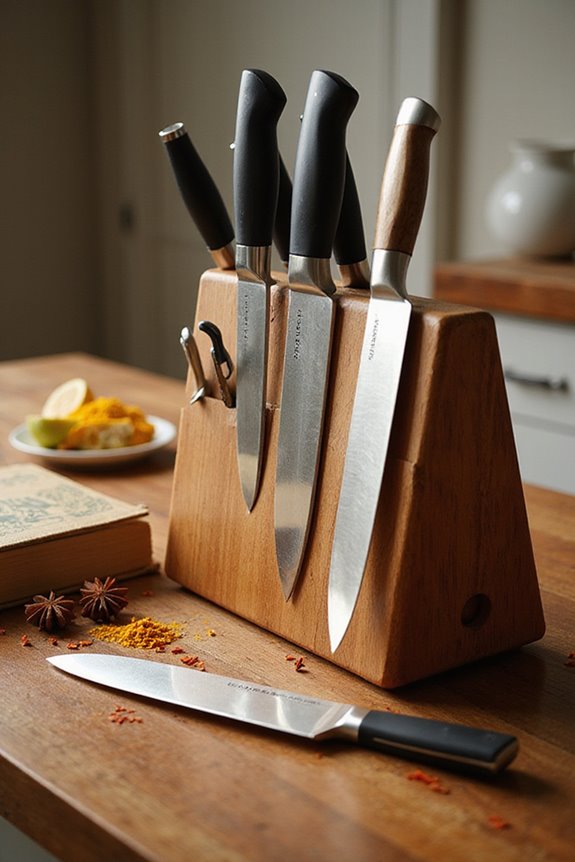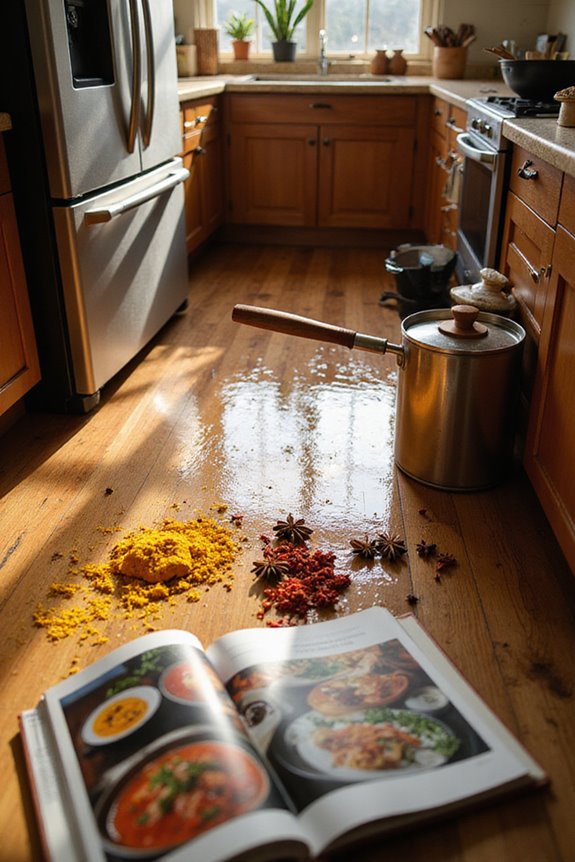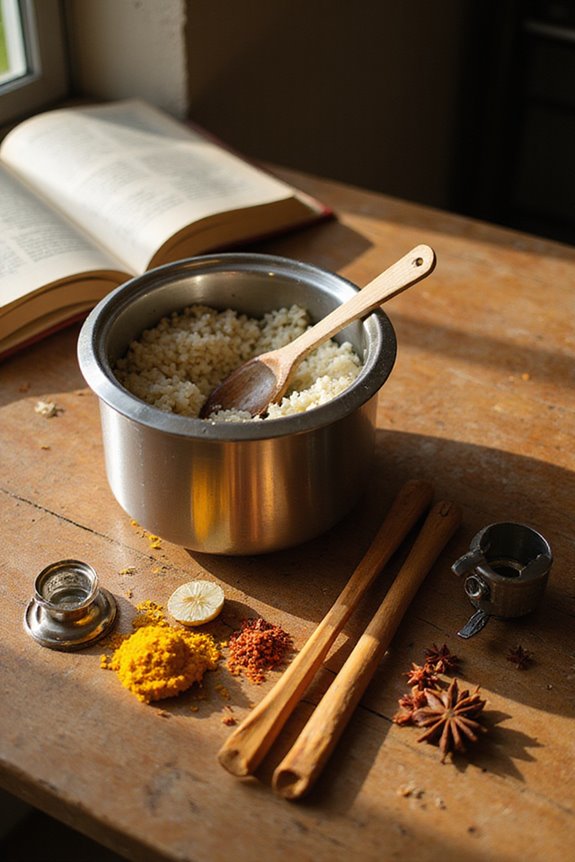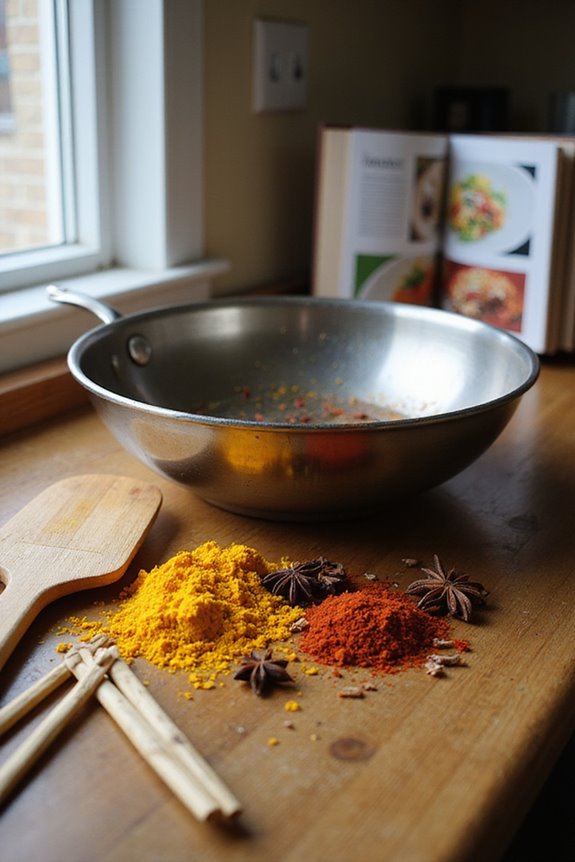Stains on our knives can be annoying, but fear not! We’ve got some delightful methods to bring back their shine. Try soaking the blade in white vinegar for 15-30 minutes or make a paste with baking soda and water to let it work its magic for 1-2 hours. For a fun twist, use a lemon with salt – it’s like a citrus spa day for your knife! Remember, keeping them clean and dry after use is key. Stick around for more enchanting tips!
Key Takeaways
- Soak the knife blade in white vinegar for 15-30 minutes for minor rust or overnight for stubborn stains.
- Create a thick paste with baking soda and water, apply it to stains, and scrub gently after 1-2 hours.
- Combine salt and lemon juice on rust spots, let it sit for 30 minutes to 2 hours, then scrub with lemon rind.
- Use a cut potato coated with dish soap and coarse salt to rub away rust effectively.
- Prevent stains by cleaning knives immediately, drying them thoroughly, and applying food-grade mineral oil regularly.
Vinegar Method for Stain Removal
When it comes to removing stains from our trusty kitchen knives, the vinegar method is nothing short of magical! 🌟 Using vinegar can be both fun and effective, especially since it harnesses the power of acetic acid to break down rust. Here’s how we can tackle our rust treatment:
- Vinegar Application: Submerge the knife blade in white vinegar for 15-30 minutes for minor rust. For stubborn stains, let it soak overnight.
- Gentle Scrub: After soaking, use a soft sponge or an old toothbrush to gently scrub away the rust.
- Final Touch: Rinse thoroughly with soap and water, then dry completely to keep new rust at bay!
Additionally, using high-quality knives, such as those from premium knife sets, can prevent rust and stains in the first place! Let’s embrace this delightful trick and keep our knives shining like new!
Baking Soda Method
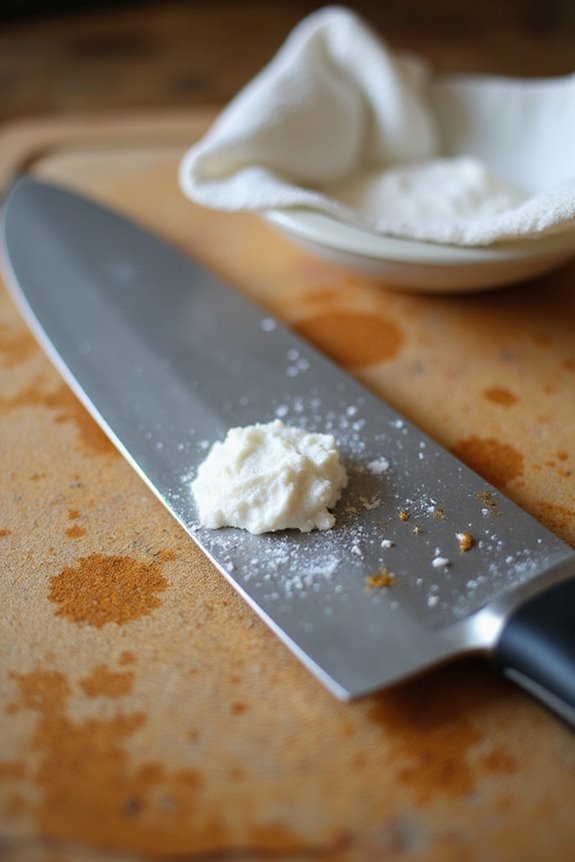
The delightful baking soda method is one of our favorite tricks for banishing light rust from kitchen knives! This magical technique is straightforward and packed with baking soda benefits. To start, we mix a few tablespoons of baking soda with just enough water to create a thick paste.
- Application: Spread the paste on rust spots and let it sit for 1 to 2 hours.
- Scrubbing: Afterward, gently scrub with a soft sponge or cloth.
- Rinse and Dry: Rinse it clean with warm water and dry thoroughly with a soft towel. This method isn’t just effective for tackling rust; it also helps with rust prevention, making it a great choice for maintaining stainless steel utensils in optimal condition. So, let’s keep those knives shining bright like holiday lights!
Lemon and Salt Technique
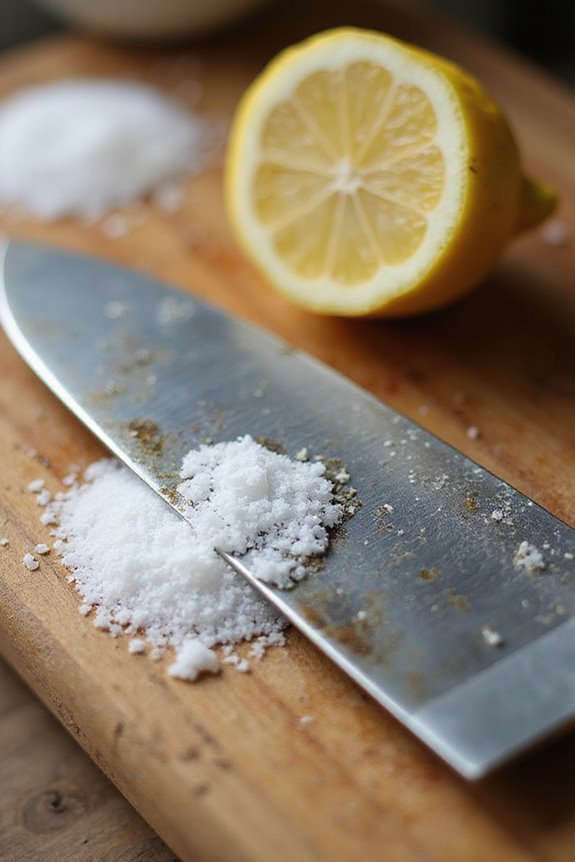
After we’ve tackled light rust with the delightful baking soda method, it’s time to contemplate the magical lemon and salt technique! This simple rust removal method uses natural ingredients we probably have at home. Here’s how we do it:
- Cut a Lemon: Slice a fresh lemon in half.
- Sprinkle Salt: Generously cover the rust with salt.
- Apply Lemon Juice: Squeeze lemon juice over the salt until it’s well-saturated.
- Let it Soak: Allow this zesty mix to sit for 30 minutes to two hours.
- Scrub Away: Use the lemon rind to gently scrub, avoiding scratches.
It’s an eco-friendly way to clean our knives, which is essential for maintaining the longevity of your kitchen equipment. Let’s love those blades back to life with this citrusy charm!
Potato and Dish Soap Approach
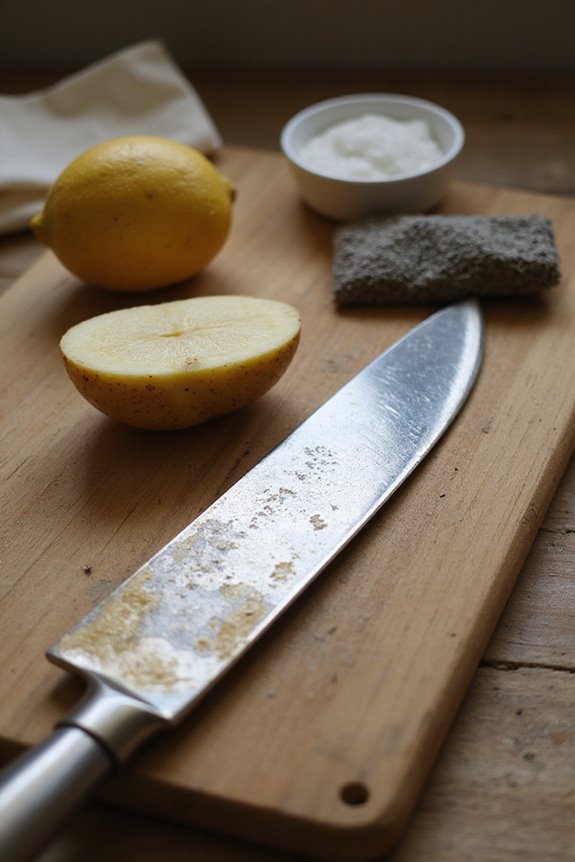
Let’s plunge into a delightful kitchen remedy to banish those pesky stains and rust from our beloved knife blades—meet the magical potato and dish soap approach! Here’s how we do it:
- Preparation: Grab a raw potato and cut it in half.
- Apply: Generously coat one cut side with dish soap. Sprinkle coarse salt or baking soda as a gentle abrasive.
Now, let’s rub that soapy potato half on our stained knife! Don’t rush—apply consistent pressure until those stubborn rust spots begin to lift. Thanks to the potato benefits, especially oxalic acid, and the cleaning efficiency of soap and salt, our knives will shine again! Additionally, using a knife-safe surface can prevent dulling of blades during the cleaning process.
Finally, rinse and dry our knife thoroughly to keep it safe from new rust. Voilà! Happy cooking!
General Care Tips to Prevent Stains
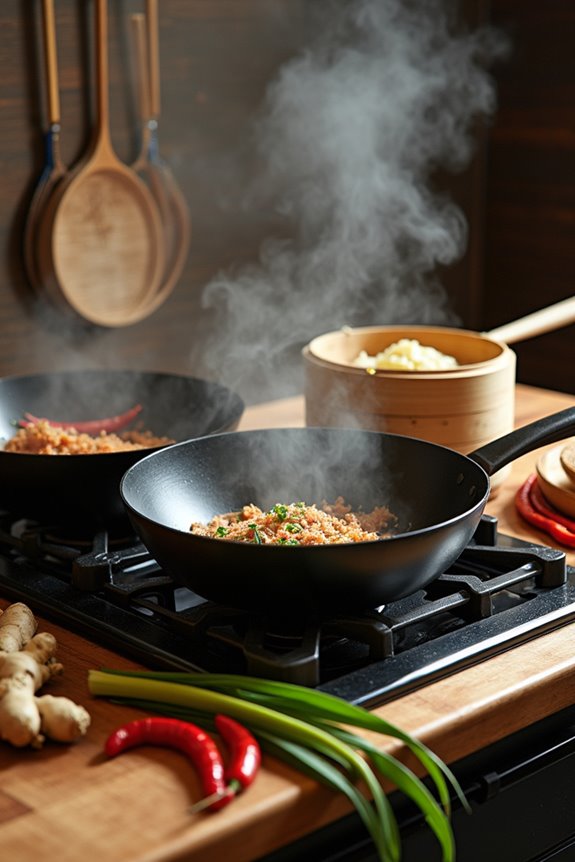
To keep our knives looking delightful and stain-free, it’s super important to adopt some simple care tips that’ll work like a magic wand in our kitchens! Here are our favorite preventive measures for knife maintenance:
- Clean Immediately: Wash knives right after cutting acidic or messy foods. Just mild dish soap and warm water will do!
- Dry Thoroughly: Lint-free towels are our best friends here—no air drying!
- Use Knife Oils: A little food-grade mineral oil creates a magical barrier against rust.
- Stay Sharp: Keeping our knives sharp not only makes cutting easier, it helps avoid trapped food residue.
- Smart Storage: Store knives in dry, ventilated places to keep the moisture monster away. Additionally, maintaining high-quality materials can enhance the longevity and performance of your knives.
Frequently Asked Questions
Can I Use These Methods on Non-Stick Knife Blades?
Absolutely, we can safely use gentle household solutions for non-stick care. Prioritizing blade safety means avoiding harsh chemicals and scrubbing too hard. Let’s keep our non-stick knives looking great without risking damage!
How Often Should I Clean My Knife to Prevent Stains?
When it comes to knife maintenance, we should establish a consistent cleaning schedule. By cleaning our knives immediately after each use, we prevent stains and guarantee they remain in top condition, ready for our next culinary adventure.
Are There Any Knives That Shouldn’t Be Soaked?
There’re definitely knives we shouldn’t soak. For instance, ceramic knives and carbon steel can rust or lose sharpness. Let’s stick to quick handwashing instead, ensuring our blades stay in top shape for all our cooking adventures!
Can I Use These Methods on Other Metal Kitchen Tools?
We can use these cleaning techniques on various metal utensils, like pots and pans. They’re effective and safe, helping us maintain our kitchen tools without damaging them. Let’s keep our kitchen shining together!
What Should I Do if Stains Persist After Cleaning?
If stains persist after cleaning, we can reassess our stain removal strategies. Let’s try more intensive cleaning techniques or specialized products, ensuring we’re gentle yet thorough to avoid damaging our kitchen tools.

